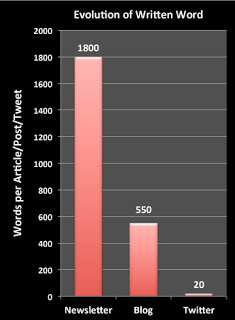I started writing about the drug industry – specifically the commercial side of the industry – in 2002 with the publication of the first issue of Pharma Marketing News. At the dawn of the social media age in 2005, I started writing Pharma Marketing Blog and in 2008, I started tweeting.
By the end of 2016 I will have written over 4 million words, which is equivalent to eighty (80) average length non-fiction books! BTW, I also co-authored a book (“Socialize Your Patient Engagement Strategy“).
Here is the breakdown of the current stats relating to my Internet publishing activities over the years:
Pharma Marketing News (started January 2002)
- 639 articles
- Over 1.2 million words (1800 words per article)
Pharma Marketing Blog (started January 2005)
- 2393 posts
- Over 2.3 million words (554 words per post)
Pharmaguy on Twitter (started March 2008)
- Over 26,000 tweets
- Over 0.5 million words (21 words per tweet)
Do you see the trend?
During the newsletter era, each article I wrote was about 1800 words. Three years later, when I started the blog, each post was about 550 words. Now, with Twitter, each tweet is about 20 words in length. So, over the years, I’ve written more “pieces” (blog posts and tweets) but have written fewer and fewer words per piece!
At the same time, I am writing fewer long newsletter articles. Up until 2012, I published an issue of Pharma Marketing News every month and each issue included about 5 articles. Now I publish an issue every quarter and each issue includes 3 articles.
This is where the information age is taking us. We have many more sources of information thanks to the Internet and social media. And we have less and less time to take in all this information. To compete, publishers of information must do two things: (1) produce shorter pieces of information, and (2) guide readers to the best information.
Content Curation
That is why I am now a fan of “content curation.”
According to WhatIs.com, “Content curation is the gathering, organizing and online presentation of content related to a particular theme or topic. As a rule, a content curation site reproduces some of the original content and links to the full entry.”
Years ago – before the term content curation became trendy in 2012 – I was curating content on Pharma Marketing Forums, which was a message board platform (read “An Online Community of Our Own“). Forum topic headings included News & Views, eMarketing, Physician Marketing, Physician Education, DTC Marketing, Disease Awareness Marketing, Market Research, and Pharmaceutical Sales.
But the Forums were not user friendly and the technology was not able to take advantage of social media “sharing.”
In September, 2014, I discovered Scoop.It and started using it for content curation. You can access my Scoop.It page here.
Since then I have curated (“scooped”) over 2700 articles, blog posts, press releases, and presentations from a variety of sources, including Pharma Marketing News and Blog. However, most of the curated content comes from third-party sources.
My scooped content is organized into 5 main topics areas:
- Pharmaguy’s Insights into Drug Industry News: This is where I post news of interest from a variety of sources.
- Pharma Marketing News, Views & Events: This is where I curate content from Pharma Marketing News, Pharma Marketing Blog, Pharma Industry News Update, and the Pharma Marketing Events Calendar.
- Pharma Industry Regulation: These are stories & insights regarding pharma marketing regulations & guidelines from FDA and other regulatory agencies.
- Social Media, Mobile, Wearable News & Views: Focuses on what’s going on in the world of pharma social media, mobile apps, mHealth, and wearable technology.
- Interviews of Pharma Industry Innovators: This includes podcasts, audio snippets, and published interviews by PharmaGuy and others.
Without interpretation and commentary, content curation would be the final stage in the “evolution of the written word”; i.e., ZERO original words per piece! That’s NOT my goal. I want to supply a service that is useful for my followers and subscribers who expect and appreciate my insights.
How do I do that?
- First, I am selective as to the content I curate, focusing almost exclusively on the marketing side of the drug industry.
- Second, I edit the content by selecting the most relevant sections to curate, leaving out the “fluff.”
- Third, in keeping with my unique point of view, I edit the headline to make it focused on what I believe is the main takeaway of the original article and of interest to my readers.
- Fourth, I add images chosen from the original article or I create unique images that add interest to the story.
- Fifth, I often add commentary in an “insights” section, which also includes links to related articles.
Comments and Sharing
Currently, I have about 16,000 followers on Scoop.It. Followers of my scoops can (1) add comments, (2) share them on Twitter, Facebook, LinkedIn and other social media sites, and (3) can “re-scoop” them into their own Scoop.It site. I also share my scoops. Each scoop is simultaneously “shared” with over 26,000 Pharmaguy Twitter followers, and about 2500 Pharmaguy LinkedIn followers. It’s interesting that I get many comments about scoops from my LinkedIn followers who are a select group of drug industry professionals.
Wither Email?
Another “victim” of the new social media information age is email, which I have used to send newsletters and third-party ads to my list of subscribers. Beginning in 2010, I have sent out 150 to 175 email messages per year to thousands of subscribes. Over 60% of these were dedicated third-party ads.
Email open rates have dropped drastically over the years because people just get too much email and most of it is considered junk, aka “spam.” Consequently, I have stopped using email to send out third-party ads and use it instead to send out summaries of content from Pharma Marketing News, curated content (Pharma Industry News Update), and the Conference Calendar Update. My subscribers now receive only one or two such emails per week versus three or four.
Some readers still like email, others prefer Twitter, and others subscribe to blogs or visit websites. In this new social media information age, it’s important that publishers use all these channels.









![6 Digital Tools at the Center of Healthcare Digitalization [INFOGRAPHIC]](http://ec2-54-175-84-28.compute-1.amazonaws.com/pharma-mkting.com/wp-content/uploads/2021/04/6DigitalTools_600px-100x70.jpg)




